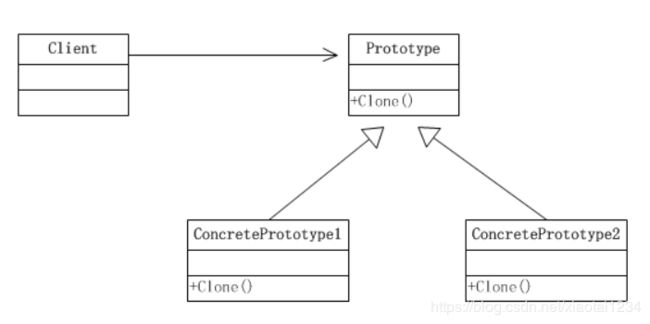设计模式-原型模式
设计模式-原型模式
1.克隆羊问题
现在有一只羊tom,姓名为: tom, 年龄为:1,颜色为:白色,请编写程序创建和tom羊属性完全相同的10只羊。
2.传统方式解决克隆羊问题
package prototype.traditional;
public class Sheep {
private String name;
private int age;
private String color;
public Sheep(String name, int age, String color) {
this.name = name;
this.age = age;
this.color = color;
}
public String getName() {
return name;
}
public void setName(String name) {
this.name = name;
}
public int getAge() {
return age;
}
public void setAge(int age) {
this.age = age;
}
public String getColor() {
return color;
}
public void setColor(String color) {
this.color = color;
}
@Override
public String toString() {
return "Sheep{" +
"name='" + name + '\'' +
", age=" + age +
", color='" + color + '\'' +
'}';
}
}
package prototype.traditional;
public class Client {
public static void main(String[] args) {
Sheep sheep1 = new Sheep("tom", 1,"白色");
Sheep sheep2 = new Sheep(sheep1.getName(), sheep1.getAge(), sheep1.getColor());
Sheep sheep3 = new Sheep(sheep1.getName(), sheep1.getAge(), sheep1.getColor());
Sheep sheep4 = new Sheep(sheep1.getName(), sheep1.getAge(), sheep1.getColor());
Sheep sheep5 = new Sheep(sheep1.getName(), sheep1.getAge(), sheep1.getColor());
System.out.println(sheep1);
System.out.println(sheep2);
System.out.println(sheep3);
System.out.println(sheep4);
System.out.println(sheep5);
}
}
3.传统的方式的优缺点
- 优点是比较好理解,简单易操作。
- 在创建新的对象时,总是需要重新获取原始对象的属性,如果创建的对象比较复杂时,效率较低
- 总是需要重新初始化对象,而不是动态地获得对象运行时的状态, 不够灵活
- 改进的思路分析
思 路 :Java中Object类是所有类的根类,Object类提供了一个clone()方法,该方法可以将一个Java对象复制一份,但是需要实现clone的Java类必须要实现一个接口Cloneable,该接口表示该类能够复制且具有复制的能力 => 原型模式
4.原型模式介绍以及实现
- 原型模式(Prototype模式)是指:用原型实例指定创建对象的种类,并且通过拷贝这些原型,创建新的对象
- 原型模式是一种创建型设计模式,允许一个对象再创建另外一个可定制的对象,无需知道如何创建的细节
- 工作原理是:通过将一个原型对象传给那个要发动创建的对象,这个要发动创建的对象通过请求原型对象拷贝它们自己来实施创建,即 对象.clone()
- 形象的理解:孙大圣拔出猴毛, 变出其它孙大圣
原型模式原理结构图- - uml 类图

Prototype : 原型类,声明一个克隆自己的接口
ConcretePrototype: 具体的原型类, 实现一个克隆自己的操作
Client: 让一个原型对象克隆自己,从而创建一个新的对象(属性一样)
原型模式解决克隆羊问题
package prototype.improve;
public class Sheep implements Cloneable{
private String name;
private int age;
private String color;
public Sheep(String name, int age, String color) {
this.name = name;
this.age = age;
this.color = color;
}
public String getName() {
return name;
}
public void setName(String name) {
this.name = name;
}
public int getAge() {
return age;
}
public void setAge(int age) {
this.age = age;
}
public String getColor() {
return color;
}
public void setColor(String color) {
this.color = color;
}
@Override
public String toString() {
return "Sheep{" +
"name='" + name + '\'' +
", age=" + age +
", color='" + color + '\'' +
'}';
}
@Override
protected Object clone(){
Sheep sheep = null;
try {
sheep = (Sheep)super.clone();
} catch (CloneNotSupportedException e) {
e.printStackTrace();
}
return sheep;
}
}
package prototype.improve;
public class Client {
public static void main(String[] args) {
Sheep sheep1 = new Sheep("tom", 1,"白色");
Sheep sheep2 = (Sheep)sheep1.clone();
Sheep sheep3 = (Sheep)sheep1.clone();
Sheep sheep4 = (Sheep)sheep1.clone();
Sheep sheep5 = (Sheep)sheep1.clone();
System.out.println(sheep1);
System.out.println(sheep2);
System.out.println(sheep3);
System.out.println(sheep4);
System.out.println(sheep5);
}
}
5.原型模式在Spring框架中源码分析
Spring中原型bean的创建,就是原型模式的应用

6.浅拷贝的介绍
- 对于数据类型是基本数据类型的成员变量,浅拷贝会直接进行值传递,也就是将该属性值复制一份给新的对象。
- 对于数据类型是引用数据类型的成员变量,比如说成员变量是某个数组、某个类的对象等,那么浅拷贝会进行引用传递,也就是只是将该成员变量的引用值(内存地址)复制一份给新的对象。因为实际上两个对象的该成员变量都指向同一个实例。在这种情况下,在一个对象中修改该成员变量会影响到另一个对象的该成员变量值
- 前面我们克隆羊就是浅拷贝
- 浅拷贝是使用默认的 clone()方法来实现
sheep = (Sheep) super.clone();
7.深拷贝基本介绍
- 复制对象的所有基本数据类型的成员变量值
- 为所有引用数据类型的成员变量申请存储空间,并复制每个引用数据类型成员变量所引用的对象,直到该对象可达的所有对象。也就是说,对象进行深拷贝要对整个对象进行拷贝
- 深拷贝实现方式1:重写clone方法来实现深拷贝
- 深拷贝实现方式2:通过对象序列化实现深拷贝(推荐)
8.深拷贝的实现代码
package com.atguigu.prototype.deepclone;
import java.io.Serializable;
public class DeepCloneableTarget implements Serializable, Cloneable {
/**
*
*/
private static final long serialVersionUID = 1L;
private String cloneName;
private String cloneClass;
//构造器
public DeepCloneableTarget(String cloneName, String cloneClass) {
this.cloneName = cloneName;
this.cloneClass = cloneClass;
}
//因为该类的属性,都是String , 因此我们这里使用默认的clone完成即可
@Override
protected Object clone() throws CloneNotSupportedException {
return super.clone();
}
}
package com.atguigu.prototype.deepclone;
import java.io.ByteArrayInputStream;
import java.io.ByteArrayOutputStream;
import java.io.ObjectInputStream;
import java.io.ObjectOutputStream;
import java.io.Serializable;
public class DeepProtoType implements Serializable, Cloneable{
public String name; //String 属性
public DeepCloneableTarget deepCloneableTarget;// 引用类型
public DeepProtoType() {
super();
}
//深拷贝 - 方式 1 使用clone 方法
@Override
protected Object clone() throws CloneNotSupportedException {
Object deep = null;
//这里完成对基本数据类型(属性)和String的克隆
deep = super.clone();
//对引用类型的属性,进行单独处理
DeepProtoType deepProtoType = (DeepProtoType)deep;
deepProtoType.deepCloneableTarget = (DeepCloneableTarget)deepCloneableTarget.clone();
// TODO Auto-generated method stub
return deepProtoType;
}
//深拷贝 - 方式2 通过对象的序列化实现 (推荐)
public Object deepClone() {
//创建流对象
ByteArrayOutputStream bos = null;
ObjectOutputStream oos = null;
ByteArrayInputStream bis = null;
ObjectInputStream ois = null;
try {
//序列化
bos = new ByteArrayOutputStream();
oos = new ObjectOutputStream(bos);
oos.writeObject(this); //当前这个对象以对象流的方式输出
//反序列化
bis = new ByteArrayInputStream(bos.toByteArray());
ois = new ObjectInputStream(bis);
DeepProtoType copyObj = (DeepProtoType)ois.readObject();
return copyObj;
} catch (Exception e) {
// TODO: handle exception
e.printStackTrace();
return null;
} finally {
//关闭流
try {
bos.close();
oos.close();
bis.close();
ois.close();
} catch (Exception e2) {
// TODO: handle exception
System.out.println(e2.getMessage());
}
}
}
}
package com.atguigu.prototype.deepclone;
public class Client {
public static void main(String[] args) throws Exception {
// TODO Auto-generated method stub
DeepProtoType p = new DeepProtoType();
p.name = "宋江";
p.deepCloneableTarget = new DeepCloneableTarget("大牛", "小牛");
//方式1 完成深拷贝
// DeepProtoType p2 = (DeepProtoType) p.clone();
//
// System.out.println("p.name=" + p.name + "p.deepCloneableTarget=" + p.deepCloneableTarget.hashCode());
// System.out.println("p2.name=" + p.name + "p2.deepCloneableTarget=" + p2.deepCloneableTarget.hashCode());
//方式2 完成深拷贝
DeepProtoType p2 = (DeepProtoType) p.deepClone();
System.out.println("p.name=" + p.name + "p.deepCloneableTarget=" + p.deepCloneableTarget.hashCode());
System.out.println("p2.name=" + p.name + "p2.deepCloneableTarget=" + p2.deepCloneableTarget.hashCode());
}
}
9.原型模式的注意事项和细节
- 创建新的对象比较复杂时,可以利用原型模式简化对象的创建过程,同时也能够提高效率
- 不用重新初始化对象,而是动态地获得对象运行时的状态
- 如果原始对象发生变化(增加或者减少属性),其它克隆对象的也会发生相应的变化,无需修改代码
- 在实现深克隆的时候可能需要比较复杂的代码
- 缺点:需要为每一个类配备一个克隆方法,这对全新的类来说不是很难,但对已有的类进行改造时,需要修改其源代码,违背了ocp原则